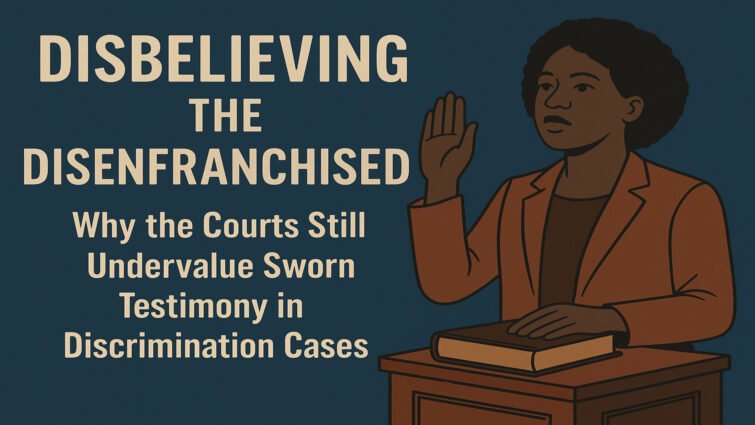In Knox v. CRC Management Co., LLC, the Second Circuit did more than reverse a district court’s grant of summary judgment—it delivered a powerful indictment of a systemic judicial blind spot: the persistent undervaluing of plaintiffs’ sworn testimony in employment discrimination cases. Natasha Knox, a Black woman of Jamaican descent, alleged racial harassment, retaliation, and wage theft during her time as a laundromat worker. Despite detailed declarations, corroborative patterns, and temporal proximity between her complaints and termination, the district court dismissed every claim, implicitly reasoning that her testimony alone was insufficient. The Second Circuit, however, disagreed.
This wasn’t just a legal correction but a doctrinal course realignment. It reaffirmed what civil rights advocates have long argued: when courts label plaintiffs’ affidavits as “self-serving” and treat them as suspect without proper evidentiary analysis, they do not apply the law—they reinforce structural disbelief. And for low-wage workers, women of color, and immigrants who experience discrimination that leaves no paper trail, this disbelief is not just frustrating. It is fatal to justice.
I. The “Self-Serving” Affidavit Fallacy
In the realm of employment discrimination, plaintiffs are routinely expected to produce corroborating documents, third-party witnesses, or smoking-gun emails. When they don’t—often because they can’t—they are told that their accounts, though sworn, are “self-serving.” Courts use this term to imply that such declarations lack credibility or probative value. But this characterization is a misapplication of evidentiary law.
As the Second Circuit has repeatedly made clear, an affidavit or deposition based on personal knowledge is competent evidence. Its truth is for the jury to determine, not for the court to pre-emptively discard at summary judgment. In Danzer v. Norden Systems, Inc., 151 F.3d 50 (2d Cir. 1998), the court explicitly rejected the notion that uncorroborated testimony could be disregarded merely because it came from the plaintiff. “The summary judgment rule would be rendered sterile,” the court warned, “were courts to accept this line of argument.”
Yet, in practice, many district courts still discredit plaintiff affidavits—particularly those from marginalized individuals in low-wage sectors. Their testimony is held to an impossible standard of neutrality, as if they are less credible simply because they have something at stake. The irony is glaring: defendants—usually employers or institutions—routinely submit HR-generated declarations that are every bit as “self-serving,” yet are rarely treated with the same suspicion.
The result? An evidentiary double standard that disproportionately harms those most likely to experience unlawful treatment—and least likely to have access to documentary evidence or internal witnesses.
II. The Legal Sufficiency of Sworn Testimony
In Zann Kwan v. Andalex Group LLC, 737 F.3d 834 (2d Cir. 2013), the Second Circuit reaffirmed that plaintiffs may establish pretext—and thus survive summary judgment—by showing “weaknesses, implausibilities, inconsistencies, or contradictions” in an employer’s stated reason for adverse action. They need not present direct evidence of discriminatory motive. Testimony, temporal proximity, and circumstantial patterns can suffice.
The same court’s decision in Mihalik v. Credit Agricole Cheuvreux North America, Inc., 715 F.3d 102 (2d Cir. 2013), expanded on this theme in the context of the New York City Human Rights Law (NYCHRL), holding that plaintiffs are not required to prove a prima facie case through rigid burden-shifting. The core inquiry is whether the plaintiff was treated less well, at least partly because of a protected characteristic—and testimony alone may answer that question.
Knox underscores the importance of these rulings. Knox testified in detail about racially charged remarks by her supervisors, the timing of her termination following protected complaints, and the employer’s inconsistent application of its reimbursement policy. She even identified similarly situated employees who were not disciplined for the same conduct. Still, the district court dismissed her case—minimizing her declarations and elevating the employer’s denials.
That approach violated both legal precedent and evidentiary principle. Courts must evaluate summary judgment evidence in the light most favorable to the non-movant. When a plaintiff swears under oath to a sequence of events and provides a coherent narrative rooted in lived experience, that testimony cannot be discarded simply because it lacks institutional validation.
III. Unequal Weight: Corporate Declarations as Gospel
One of the more insidious dynamics in employment litigation is the unspoken asymmetry in how courts treat the respective affidavits of plaintiffs and defendants. When an employer submits a declaration from a manager, HR representative, or general counsel, it is often accepted at face value—as if its institutional origin confers neutrality or truth. Meanwhile, plaintiff declarations—particularly those in hourly or precarious jobs—are dissected for bias, tone, and presumed exaggeration.
This evidentiary imbalance reflects deeper societal presumptions about race, class, gender, and power. It equates professionalism with credibility and assumes that power structures are more trustworthy than those they control. However, as Knox clarifies, that assumption is empirically unfounded and legally impermissible. The fact that a plaintiff stands alone in telling her story does not render it unworthy of belief.
Indeed, the entire point of the anti-discrimination law is to give a voice to those excluded by institutional channels. If testimony grounded in personal experience and sworn under penalty of perjury is dismissed as “self-serving,” then the law has effectively excluded the people it purports to protect.
Conclusion: Reclaiming the Testimonial Voice in Civil Rights Litigation
Knox is not just a case about laundry wages or racist insults—it is a jurisprudential stand against a deeper culture of disbelief that pervades civil rights enforcement. By restoring the credibility of the plaintiff’s voice and rejecting the misuse of summary judgment to screen out “self-serving” narratives, the Second Circuit reaffirmed the jury’s role in adjudicating contested facts.
Courts must remember that the truth often arrives without corroboration. It comes in the voice of a woman fired without documentation, harassed without witnesses, and retaliated against in ways no policy manual will ever record. Discrimination law becomes a paper shield if that voice is silenced at the summary judgment stage. If it is heard—credited, contextualized, and allowed to reach a jury—then the law retains its force.
The testimonial voice matters. And in Knox, the judiciary finally listened.





